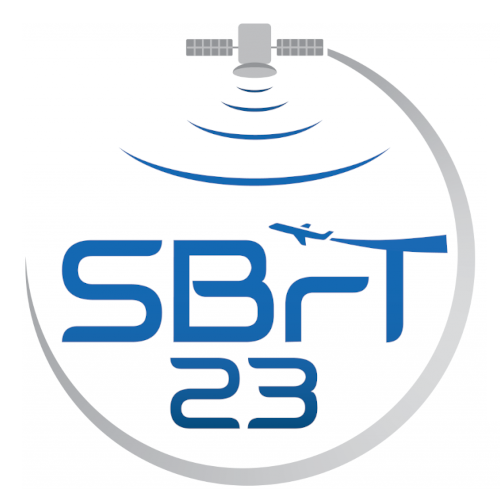
XLI Simpósio Brasileiro de Telecomunicações e Processamento de Sinais

Simultaneous Factorization of Multiple Khatri-Rao and Kronecker Matrix Products in MIMO systems
Walter da Cruz Freitas Jr., Lucas Abdalah, André de Almeida
DOI: 10.14209/sbrt.2023.1570922852
Keywords: Tensor PARAFAC Khatri-Rao product Kronecker product
Abstract
In this paper, we present a singular value decomposition (SVD)-based rank-one approximation algorithm to estimate simultaneously each symbol matrix of the multiple Khatri-Rao product-based space time (MKRST) coding. We modeled such estimation problem in a multiple input multiple output (MIMO) space-time coding scenario. As shown in our simulation results, the proposed algorithm is capable of avoid error propagation inherent to the iterative closed-form solution when the MKRST coding is considered, keeping the same complexity of the high-order SVD (HOSVD) approach.Download
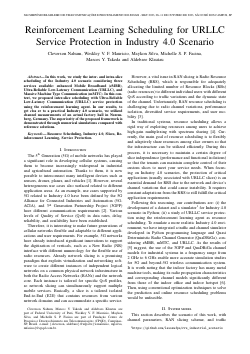
Reinforcement Learning Scheduling for URLLC Service Protection in Industry 4.0 Scenario
Cleverson Nahum, Weskley Maurício, Maykon Silva, Michelle Soares Pereira Facina, Marcos Takeda, Aldebaro Klautau
DOI: 10.14209/sbrt.2023.1570922913
Keywords: Resource Scheduling Industry 4.0 Slices Reinforcement Learning
Abstract
In this work, we study the inter- and intra-slice scheduling of the Industry 4.0 scenario considering three services available: enhanced Mobile Broadband (eMBB), Ultra-Reliable Low-Latency Communication (URLLC), and Massive Machine Type Communication (mMTC). In this context, we proposed inter-slice scheduling with Ultra-Reliable Low-Latency Communication (URLLC) service protection using the reinforcement learning agent. In our results, to get closer to a practical Industry 4.0 scenario, we utilized channel measurements of an actual factory hall in Nuremberg, Germany. The superiority of the proposed framework is demonstrated through numerical simulations compared with reference solutions.Download
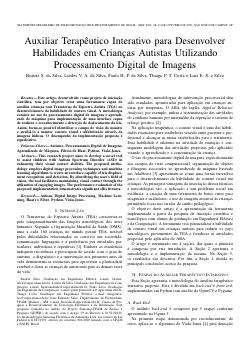
Auxiliar Terapêutico Interativo para Desenvolver Habilidades em Crianças Autistas Utilizando Processamento Digital de Imagens
Luiz Eduardo Sales e Silva, Beatriz Silva, Lurdes Vitória Silva, Paulo Henrique Silva, Thiago Costa
DOI: 10.14209/sbrt.2023.1570922987
Keywords: Autismo Processamento Digital de Imagens Aprendizado de Máquina Filtros de Haar
Abstract
This research project aims to develop a novel tool to assist children with Autism Spectrum Disorder (ASD) in enhancing their visual contact abilities. The proposed methodology employs digital image processing techniques and machine learning algorithms to create an interface capable of iris displacement recognition and detection. By identifying the user's field of vision, the tool facilitates maintaining visual contact through the utilization of engaging images. The performance evaluation of the proposed methodology demonstrates significant effectiveness.Download

DINO: Dynamic and Intelligent Network Operative for Secure and Efficient Access to the Edge Network Computing Environment
Caio Storni, Diogo M. F. Mattos, Dianne Medeiros
DOI: 10.14209/sbrt.2023.1570923159
Keywords: Multi-access Edge Computing Network Security Network Virtualization Edge Network Computing
Abstract
Multi-access Edge Computing (MEC) extends cloud computing to the network's edge, placing MEC servers closer to End Devices (EDs). This paradigm aims to respond locally to computing tasks, reducing the routed data to the core network and the communication latency. Nevertheless, offloaded task requests may congest MEC servers and incur increased waiting times. Therefore, this paper proposes the Dynamic and Intelligent Network Operative (DINO) MEC server, an edge computing host server that securely and efficiently handles task offloading. The proposal spans the MEC server from the ED premises to the edge network. DINO splits into Customer Premises Equipment (CPE) and Virtualized Infrastructure (VI), and relies on a modular architecture that allows the CPE to be placed anywhere between the ED's premises and the VI running in the edge network. We assess DINO's performance varying the numbers of EDs to verify how the modular architecture affects the network overhead and delay. Results show that the experimented delay due to the proposed MEC server is minimal, being outgrown by the delay due to the medium access control protocol. The network overhead is negligible, allowing EDs accessing an edge service to achieve the same data rate as the EDs accessing a cloud serviceDownload
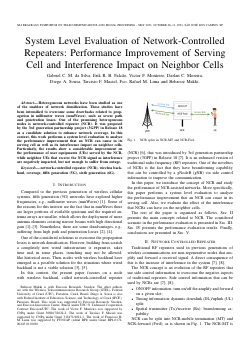
System Level Evaluation of Network-Controlled Repeaters: Performance Improvement of Serving Cell and Interference Impact on Neighbor Cells
Gabriel Carlini Monte da Silva, Erik Ray B. Falcão, Victor Farias Monteiro, Darlan C. Moreira, Diego Aguiar Sousa, Tarcisio F. Maciel, Francisco Rafael Marques Lima, Behrooz Makki
DOI: 10.14209/sbrt.2023.1570923164
Keywords: network-controlled repeater (NCR) wireless backhaul coverage fifth generation (5G)
Abstract
Heterogeneous networks have been studied as one of the enablers of network densification. These studies have been intensified to overcome some drawbacks related to propagation in millimeter waves (mmWaves), such as severe path and penetration losses. One of the promising heterogeneous nodes is network-controlled repeater (NCR). It was proposed by the 3rd generation partnership project (3GPP) in Release 18 as a candidate solution to enhance network coverage. In this context, this work performs a system level evaluation to analyze the performance improvement that an NCR can cause in its serving cell as well as its interference impact on neighbor cells. Particularly, the results show a considerable improvement on the performance of user equipments (UEs) served by the NCR, while neighbor UEs that receive the NCR signal as interference are negatively impacted, but not enough to suffer from outage.Download

Reconhecimento de Cargas em Sistemas Residenciais de Gestão de Energia por meio de Algoritmos Baseados em Árvores de Decisão
Thales Wulfert Cabral, Guto Mendes, Fernando Bauer, Eduardo de Lima, Gustavo Fraidenraich, Luís Geraldo P. Meloni
DOI: 10.14209/sbrt.2023.1570923175
Keywords: Machine learning Load Recognition XGBoost
Abstract
For the efficient management of domestic energy demand, technology has carried innovative equipment such as the Home Energy Management System (HEMS). As an extension of [5], this article adopts new alternatives for the fast training chain of models to load recognition in HEMS. The contributions are (i) the inclusion of Extreme Gradient Boosting (XGBoost) to load recognition, (ii) the addition of robust techniques for feature extraction, and (iii) new analyses employing these techniques along with the old tree-based models. Finally, the results indicate XGBoost as the winning alternative, achieving superior performance values compared to rivals.Download
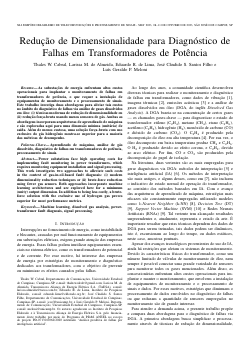
Redução de Dimensionalidade para Diagnóstico de Falhas em Transformadores de Potência
Thales Wulfert Cabral, Larissa Almeida, Eduardo de Lima, José Cândido Silveira Santos Filho, Luís Geraldo P. Meloni
DOI: 10.14209/sbrt.2023.1570923197
Keywords: Machine learning dissolved gas analysis power transformer fault diagnosis signal processing
Abstract
Power substations face high operating costs for implementing fault monitoring in power transformers, which requires monitoring equipment installation and signal processing. This work investigates two approaches to alleviate such costs in the context of gas-in-oil-based fault diagnosis: (i) modern dimensionality reduction techniques or (ii) brute-force reduction using fewer gas sensors. Both approaches incorporate machine learning architectures and are explored here for a minimum (unity) output dimension. In addition to being less costly, a brute-force solution with the exclusive use of hydrogen gas proves superior for most performance metrics.Download
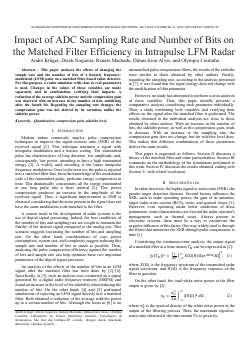
Impact of ADC Sampling Rate and Number of Bits on the Matched Filter Efficiency in Intrapulse LFM Radar
Andre Martins Kruger, Derek Nogueira, Renato Machado, Dimas Irion Alves, Olympio Coutinho
DOI: 10.14209/sbrt.2023.1570923223
Keywords: Quantization Compression gain Sidelobe level
Abstract
This paper analyzes the effects of changing the sample rate and the number of bits of a linearly frequency- modulated (LFM) pulse on a matched filter-based radar detector. For this purpose, a radar simulator with close to real parameters is used. Changes in the values of those variables are made separately and in combination, verifying their impacts. A reduction of the average sidelobe power and the compression gain was observed with an increase in the number of bits, stabilizing after the fourth bit. Regarding the sampling rate changes, the compression gain was not altered by its variation, unlike the sidelobe power.Download
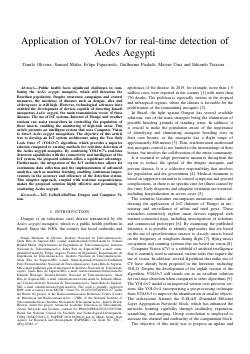
Application of YOLOv7 for real-time detection of Aedes Aegypti
Danilo Machado de Oliveira, Samuel Mafra, Felipe Augusto Pereira de Figueiredo, Guilherme Pires Pieadade, Mateus R Cruz, Eduardo Henrique Teixeira
DOI: 10.14209/sbrt.2023.1570923269
Keywords: IoT LoRa/LoRaWan Dengue Computer Vision
Abstract
Public health faces significant challenges in combating the Aedes aegypti mosquito, which still threatens Brazilian population. Despite awareness campaigns and control measures, the incidence of diseases such as dengue, zika and chikungunya is still high. However, technological advances have enabled the development of devices capable of detecting Aedes aegypti female mosquitos, the main transmission vector of these diseases. The use of IoT (Internet of Things) systems and weather stations can help researchers in controlling the population of these insects, enabling the monitoring of high-risk areas. This article presents an intelligent system applying Computer Vision to detect Aedes aegypti mosquitos. The objective of this article is to present an IoT system architecture using the You Only Look Once v7 (YOLOv7) algorithm, which provides a better solution compared to others existing methods for real-time Aedes aegypti detection. By combining YOLOv7's real-time detection capabilities with the connectivity and intelligence of the IoT system, the proposed solution offers a significant advantage. Furthermore, the integration of the IoT architecture allows for continuous data collection and the implementation of advanced analytics, such as machine learning (ML), enabling improvements in the accuracy and efficiency of the detection system. This adaptive approach, joint the real-time responsiveness, makes the proposed solution highly effective and promising in combating Aedes aegypti.Download

Caracterização Numérica de Células Unitárias com Linhas de Atraso de Fase para Redes Refletoras Impressas
Suyane P. Campos, Marcos V. T. Heckler, Edson R. Schlosser
DOI: 10.14209/sbrt.2023.1570923277
Keywords: Redes de antenas refletoras Linhas de atraso de fase Espalhadores impressos
Abstract
This paper presents the phase responses of circular-shaped scaterrers with phase-delay lines for operation at 9.6~GHz. The curves indicate a wide range of phase values obtained by varying the length of the phase-delay lines. The behavior of the three analyzed structures is suitable for the integration into a reflectarray in the future.Download